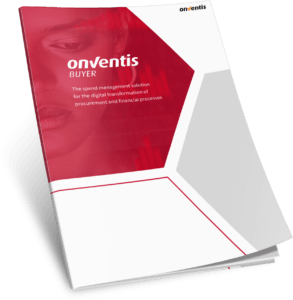How e-Procurement Platforms Boost Efficiency & Resilience
The 2025 Procurement Barometer, Onventis’ annual study analyzing procurement trends and challenges for MSEs in the DACH region, reveals that reliable supply chains are still far from guaranteed. Inflation, compliance demands, and supply disruptions are reshaping procurement priorities. To adapt, companies are turning to strategies like multi-sourcing, safety stock, and long-term supplier contracts. However, these strategies fall short when procurement processes remain slow or manual. This blog highlights key results from the study and explores how e-Procurement platforms can close this gap.

These platforms centralize data, automate repetitive tasks, and standardize workflows, allowing procurement teams to collaborate more effectively and act on real-time insights. For mid-sized businesses, they offer scalability and the ability to adapt quickly to market changes without adding operational complexity.
Boosting Process Efficiency Through Digital Procurement
Manual procurement processes often result in delays, errors, and unnecessary costs. e-Procurement solutions, on the contrary, simplify the whole purchasing cycle, from request for quotation until payment, in a cost-efficient manner.
Key findings from the Procurement Barometer 2025 highlight this trend:
- 68.1% of MSEs see these solutions as a means of speeding up procedures and reducing manual work. They offer speed, consistency and control.
- 59.5% report that resource constraints make automation essential for meeting rising demands.
Digital platforms automate repetitive tasks, standardize approvals, and provide real-time visibility of purchasing activities. That translates into fewer delays, accurate data and an efficient flow in general.
How e-Procurement platforms strengthen supplier resilience
Procurement resilience – the ability to adapt to disruptions, recover quickly, and continue delivering value – has become a top priority for MSEs.
The study data highlights significant challenges:
- 53.5% of companies surveyed report declining supplier reliability due to recent supply chain shocks.
- 68.5% have faced cost increases as a direct consequence of disruptions.
This is where e-Procurement platforms demonstrate their full potential. By providing real-time insights, scorecards and automated monitoring, these platforms empower procurement teams to identify risks promptly, respond swiftly and collaborate more effectively with suppliers.
Strengthening collaboration through supplier onboarding and communication
Effective supplier collaboration starts with consistent onboarding and transparent communication. Yet, many MSEs still manage these processes manually, leading to misaligned expectations and compliance risks.
The Barometer reveals that 51.7% of companies consider systematic supplier onboarding essential for resilience.
e-Procurement platforms centralize these workflows, ensuring suppliers are integrated quickly and consistently. Standardized onboarding fosters trust, enables compliance, and provides a foundation for long-term partnerships.
If you want to be resilient, you need to set the course early on with clear onboarding processes, transparent communication, and continuous performance evaluation.
Why it’s time for MSEs to act on e-Procurement
The future of procurement is digital and collaborative. Integrated platforms have more to offer than automation. Now they deliver strategic value by bringing buyers and suppliers together in real time. Enterprises adopting e-Procurement solutions today can:
- Automate manual workloads and decrease process costs.
- Make better-informed decisions in real-time.
- Build resilience by managing suppliers proactively.
- Position themselves competitively for future challenges, from ESG compliance to AI adoption.
Weitere BlogsMore BlogsMeer blogs




